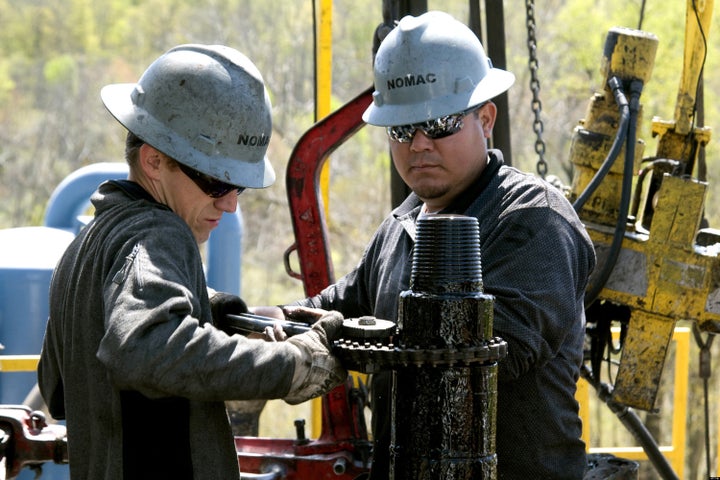
It appears the fossil fuel industry just keeps on giving... disasters. My NRDC colleague Amy Mall reports that a major New York Times investigation today reveals serious health and environmental dangers associated with the natural gas industry across the country. As if the oil industry in the Gulf didn't give us enough problems. Read Amy's great summary of the problem below.
Today The New York Times published an important story about the environmental and health impacts of natural gas production in states across our country. Everyone should read it for themselves, as well as watch the excellent video companion, and review the leaked documents that The Times has posted on line. Among the report's findings:
- Hydraulic fracturing waste contains radioactivity at levels higher than previously known and is sometimes hauled to sewage plants that cannot safely handle it and then discharged into rivers that supply drinking water. Because natural gas drilling waste is so toxic, NRDC last year asked the EPA to update the current rules governing oil and gas waste, which were written in the 1980s and leave oil and gas waste completely exempt from rules that oversee hazardous waste.
- Scientists from the U.S. Environmental Protection Agency (EPA) are alarmed and warn that the drilling waste is a threat to drinking water in Pennsylvania. The Times reviewed thousands of documents, including never-reported studies by the EPA, and has posted many on its website.
- Air quality in rural western areas in Wyoming has failed to meet federal standards for air quality and have experienced levels of ozone higher than those recorded in Houston and Los Angeles. This has since also occurred in Utah. I have also blogged previously about toxic levels of benzene and other dangerous poisons found in other communities near natural gas operations.
- Chidren and adults are experiencing severe illness from living near natural gas production facilities (the NYT interviewed families in Texas and Colorado), including asthma attacks, dizzy spells, headaches, nausea, diarrhea, and nosebleeds. There are families reporting these and additional symptoms, including serious neurological and other illnesses, in other states as well. I've blogged about children waking up covered in blood and families whose doctors have ordered them to evacuate their homes. There are also families across the country reporting drinking water contamination they suspect is linked to hydraulic fracturing and leaks or blow-outs in natural gas wells.
- Sickening birth defects, deaths, and other serious illnesses are occurring in livestock that are kept near natural gas operations. Government scientists are investigating birth defects in the tragic deaths of baby dolphins in the Gulf of Mexico--as they should, but not one is investigating the birth defects and other abominable sicknesses in animals that are suspected to be linked to natural gas operations and may be entering the human food chain across the country. Can someone explain that?
- More than 1.3 billion gallons of wastewater was produced by Pennsylvania natural gas wells over the past three years, far more than has been previously disclosed, and most of this water -- enough to cover Manhattan in three inches -- was sent to treatment plants not equipped to remove toxic substances in drilling waste, even though some of the waste contained radioactivity levels more than 2,000 times the drinking-water standard.
- State regulation is insufficient to protect citizens. The NYT found that, from October 2008 through October 2010, Pennsylvania officials usually gave companies only written warning for violating the law -- not a fine. And when there are fines, they are practically meaningless. Companies paid an average of about $44,000 each year--a tiny fraction of the several million dollars it costs them to drill one well. It seems that it is easier for companies to pay a fine than to do things right.
I have blogged before about how state regulations are too weak, state inspection staffs are insufficient, and penaties, when they are levied, are too low to be meaningful. And it's not just me saying it, it's state regulators themselves saying they are unprepared and overwhelmed, as I blogged about recently. Companies currently adopt the minimum standards required, which varies from state to state.
The stories of seriously ill families, and animals that may make their way into our food chain, unprotected by regulators is just tragic. But there is an incomrephensible reckless insult added to this injury--it doesn't have to be this way.
The oil and gas industry says that if it is forced to clean up its toxic mess that it will lay off workers. This is a crass piece of political spin that our elected officials should toss in the trash can. Here are the facts:
- Environmentalists care about jobs--we have no desire or interest in seeing anyone lose his or her job. That is not our goal.
- Many, if not most, of the people who are sick and who support stronger protections don't do this because they are "environmentalists." They often support oil and gas development, but also care about their children and their neighbors. They may even work or have worked in the oil and gas industry, as seen in interviews by both The Times and PBS.
- The industry does not have to operate the way it currently does. This is not a situation where the only two options are "drill and pollute at will" or "don't drill." There are many technologies, readily available, that industry can use to operate in much cleaner ways. Of course, some places should be completely off limits because they are too sensitive, such as vital watersheds, backyards, and our last remaining wilderness lands, because oil and gas production can never be completely clean or safe. But where drilling does occur, we know it can be cleaner and safer.
- The oil and gas industry can afford these cleaner technologies. Many of the cleaner approaches are actually money makers -- they don't cost the industry anything because they pay for themselves. That is not in contention; industry acknowledges this. However, the industry still does not uniformly adopt these cleaner approaches everyplace it operates.
- Government regulations are in desperate need of updating. Some of them have not been updated since the 1980s -- they do not reflect our current knowledge about the threats, the extent of risk, and the new technologies that are available. Congress must close outdated loopholes in the Clean Water Act, Clean Air Act, Safe Drinking Water Act, and the law that governs our toxic waste (the Resource Conservation and Recovery Act). Gaping loopholes in these laws allow the oil and gas industry to legally pollute and avoid compliance with the environmental laws by which other industries must abide.
- Government enforcement of the rules must be swift and strong. This industry has gotten enough slaps on the wrist. It may have red wrists, but it hasn't changed its ways. And regulators need sufficient staff. While state budgets face challenges, industry can afford the fees required to ensure healthy state agencies. The U.S. company with the largest natural gas reserves--ExxonMobil--just reported a quarterly profit of more than $9 billion.
